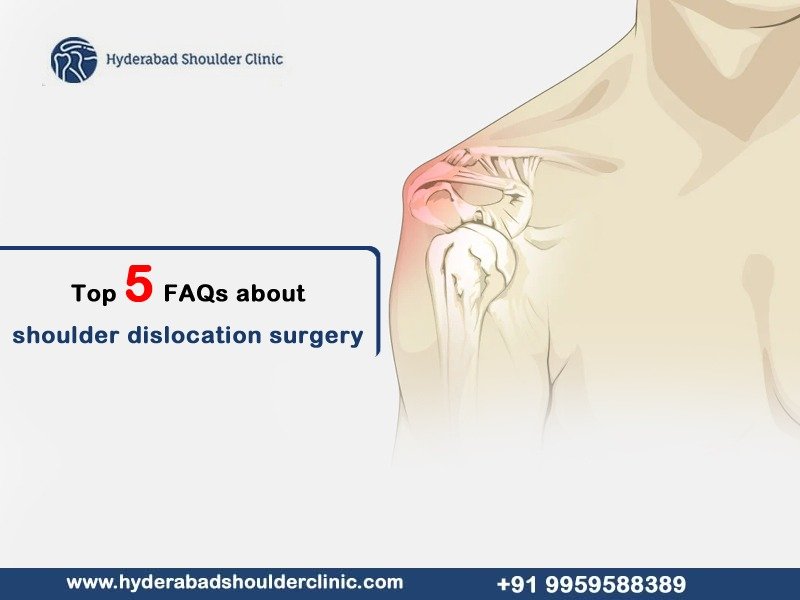The shoulder is a ‘ball and socket’ joint, and the ball is the head of the humerus. The socket is the glenoid fossa of the shoulder blade that allows a wide range of motion. Due to this ball and socket arrangement and the wide range of movements done by the shoulder, it is naturally unstable. Shoulder dislocation is a common shoulder injury when the ball comes out of the socket. If the ball comes out of the front of the socket, damaging the front of the socket, it is called an ‘anterior dislocation.’
Posterior dislocation of the shoulder is less joint where the humeral head is forced posteriorly in internal rotation while the arm is abducted. It could happen due to electrocution, road trauma, or in elders.
First-time shoulder dislocations occur due to a significant force affecting the shoulder, such as a sports injury or hard fall. There will be so much in the shoulder and arm, and the hand feels ‘stuck’ or ‘locked .’The person with a dislocated shoulder will know that they need help, but they typically will need to learn what the problem is. Following the first one, subsequent dislocations could occur due to trivial injuries, with less pain, though the arm still won’t work while the shoulder remains dislocated.
Most of the shoulder dislocations are easily diagnosed by a physiotherapist or doctor. An X-ray or a CT scan is taken to look for any related fractures. Magnetic resonance imaging (MRI) is needed if surgery is going forward.

FAQ -1 When is surgery considered for shoulder dislocation?
Surgery is usually not the first line of treatment: Experienced doctors like Dr.Chandra Sekhar. B will suggest wearing a sling for about six weeks, followed by a rehabilitation program to regain range of motion and strength, returning to normal activities after 3 – 6 months.
- When the joint cannot be put back in place by closed reduction due to a jammed tissue, the patient should have surgery performed at the earliest.
- Dislocations with accompanied injuries, such as fractures or rotator cuff tears.
- Repeated dislocations, in which case the shoulders will definitely remain unstable.
- Patients with loose ligaments.
- If there is a chance of repeated dislocations – essentially, those under the age of 40 have an active life.
FAQ – 2 What can you expect if surgery is recommended?
As part of the pre-operative planning, a normal MRI scan is done by injecting a dye into the joint. With the dye, the surgeon can identify injuries that may not be shown on plain MRI.
For most patients, arthroscopy, i.e., keyhole surgery, is done using a video camera and tiny incisions. The patient is discharged on the same day. Normal anatomy can be restored by stitching the labrum back to the glenoid using ‘bone anchors’ and knots.
In sporadic cases, an open surgery is performed for:
- Complicated fractures
- When the fracture results in many tiny breakages, it is hard to stitch together via an arthroscope.
- If previous keyhole surgeries did not heal properly.
FAQ – 3 What is the post-operation situation?
There are mainly three stages in recovery:
Surgery healing: Within six weeks, enough new collagen protein develops to heal the soft tissues powerfully.
Regaining movement: Shoulder stiffness is expected after the operation, and one cannot stretch too much. The repair area should become strong, so wait for the first six weeks before doing stretching. After that also, start doing simple exercises, followed by more aggressive stretches.
Regaining strength and endurance: With the strengthening and endurance exercises, one can recover about 90% of one’s strength by 3-6 months post-operation. But please wait for six months to do complete demanding activities like serving in tennis, driving in golf, etc. Smoking delays healing, so keep away from smoking when recovering from an injury or operation.
FAQ – 4 When can I return to work?
Returning to work depends on the nature of the work one does. If you have a regular desk job, you can start in a few days. But drivers should wait for at least six weeks. If people are in the police, fire department, etc., they have to wait for 4 – 6 months. If there is no heavy or overhead lifting, wait for about three months.
But those in heavy or overhead lifting wait for about six months. Driving is advised only after six weeks of their operation.
FAQ – 5 What is the physiotherapy schedule?

Physiotherapy should be started six weeks after the operation, and one should continue till they have achieved full recovery, which would be up to 6 months.
Physiotherapy also helps you to return to sports, as one needs to have a sufficient range of motions, strength, and endurance to perform the activity safely and reasonably well.
We at Hyderabad Shoulder Clinic have a high success rate with shoulder dislocation surgery. This is because we give equal importance to post-surgical care. We explain all the details before and after the surgery very clearly. The patient is given a clear follow-up schedule during which a proper diagnosis of the situation is made. For more information, please visit our website https://hyderabadshoulderclinic.com/ or contact us at +91 9959588389 or shoulderandsportsclinic@gmail.com.





